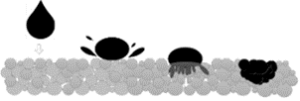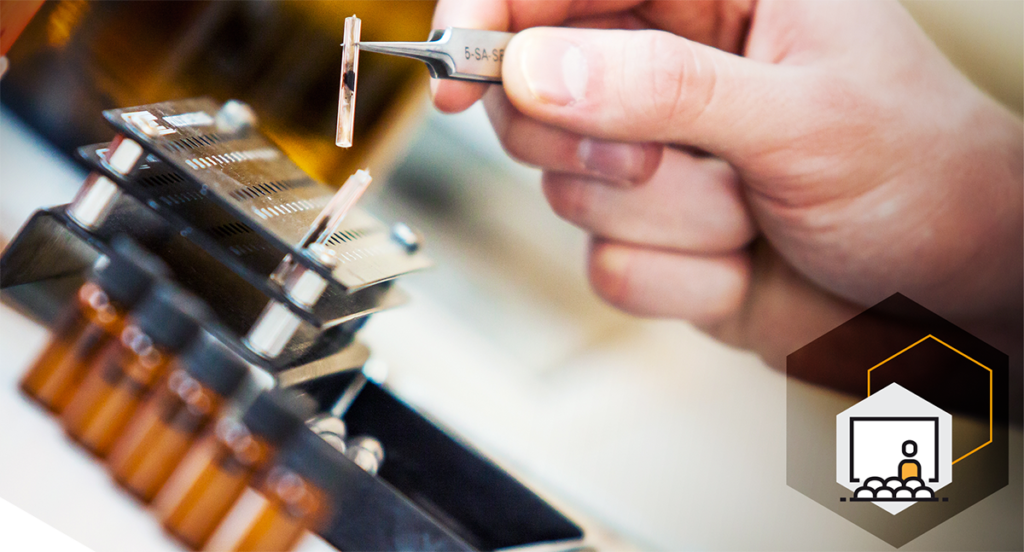Zespół badawczy 3D printing technology in molds and cores production
Skład zespołu:
- Prof. dr hab. inż. Rafał Dańko
- Dr hab. inż. Katarzyna Major-Gabryś, prof. AGH
- Dr inż. Dariusz Drożyński
- Dr inż. Mateusz Skrzyński
- Mgr inż. Daniel Gruszka
- Mgr inż. Dawid Halejcio
- Mgr inż. Agnieszka Mikuła
Zespół badaczy zajmuje się zagadnieniami dotyczącymi zastosowania techniki addytywnej –druku 3D do produkcji form i rdzeni odlewniczych.
Technologie druku 3D zaliczane są do innowacyjnych metod produkcji o charakterze addytywnym. W produkcji form i rdzeni odlewniczych zastosowanie znajduje technologia binder jetting, która pozwala na spajania ze sobą kolejnych warstw ziaren piasku przy wykorzystaniu spoiw. Schemat procesu przedstawiono na rys. 1. Jest to nowoczesna technologia, która umożliwia wykonanie form i rdzeni o kształtach i układach niemożliwych do otrzymania przy zastosowaniu tradycyjnych metod formowania. Na właściwości mechaniczne wykonywanych technologią binder jetting form i rdzeni wpływ mają parametry takie, jak czas żelowania, rozmieszczenie ziaren piasku, płaszczyzna wykonanego druku, grubość warstwy drukowanej, stosowane dodatki, a także czynniki związane z systemem druku (gęstość, rozdzielczość). Niska chropowatość oraz bardzo dobra dokładność wymiarowa pozwala na wykorzystanie technologii binder jetting również do produkcji form dla odlewnictwa precyzyjnego oraz artystycznego. Do wad technologii addytywnych zaliczyć można pojawiający się efekt schodkowania, spowodowany przez nakładanie kolejnych warstw osnowy. Efekt ten może wymusić dodatkową obróbkę powierzchni odlewu, ale można go ograniczyć przez ustawienie płaskich powierzchni prostopadle do powierzchni drukowania w celu ograniczenia jego występowania. Technologia binder jetting korzystnie wpływa na jakość odlewów. Dzięki nieograniczonym kształtom drukowanych układów możliwe jest wpływanie na szybkość odprowadzania ciepła przez formę odlewniczą i tym samym na proces krzepnięcia i krystalizacji odlewu.

Rys. 1. Schemat procesu druku 3D mas formierskich metodą binder jetting.
Na rysunku 2 przedstawiono ilustrację operacji drukowania formy w systemie Binder Jetting 3D. Warstwa piasku nakładana jest na stół roboczy przez recoater. Ciekłe spoiwo jest natryskiwane przez iniektor, opada i otacza osnowę piaskową, co w efekcie umożliwia utworzenie mostków łączących ziarna osnowy. Na utworzoną warstwę druku recoater nakłada kolejną warstwę piasku, a głowica drukarki nakrapia spoiwo. Po zakończeniu pracy głowicy drukującej stół roboczy obniża się o wysokość warstwy osnowy ceramicznej. Proces ten jest powtarzany do momentu wytworzenia docelowego rdzenia lub formy. Po wstępnym utwardzeniu usuwa się piasek, który nie został użyty w procesie

Rysunek 2. Wnikanie spoiwa w drukowaną osnowę.
Zespół dysponuje drukarką 3D, laboratorium tworzyw formierskich KOCEL AJS 300A (rys. 3). Jest to urządzenie działające w technologii Binder Jetting wykorzystujące żywice furanowe. Drukarka 3D AJS 300A firmy KOCEL jest przeznaczona dla instytutów badawczych i naukowych do wydruków doświadczalnych o polu roboczym 300x200x200mm [1].

Rys. 3 Drukarka 3D KOCEL AJS 300A [1]
Prowadzone prace dotyczą możliwości zastosowania mas formierskich z zastosowaniem różnych rodzajów osnowy oraz szerokiej gamy materiałów wiążących, które mogą być zastosowane w technologii addytywnej. Badania obejmują również możliwość zastosowania różnych typów powłok ochronnych stosowanych na wykonane w technologii druku 3D wnęki form i rdzenie.
Literatura
[1] Mostafaei A. et all (2021) Binder jet 3D printing—Process parameters, materials, properties, modeling, and challenges. Progress in Materials Science, Volume 119, doi: 10.1016/j.pmatsci.2020.100707.
[2]Amaury Le Néel T. et all. (2018) A review on additive manufacturing of sand molds by binder jetting and selective laser sintering. Rapid Prototyping Journal, Volume 24, doi: 10.1108/RPJ-10-2016-0161.
[3] Gibson, I., Rosen, D.W. and Stucker, B. (2015),; Additive manufacturing technologies. Springer, New York, doi: 10.1007/978-1-4939-2113-3.
[4] Lewandowski J.L. (1997) Tworzywa na formy odlewnicze. Akapit, Kraków
[5]Upadhyay M., Sivarupan T., El Mansori M. (2017) 3D printing for rapid sand casting—A review. Journal of Manufacturing Processes, Volume 29, pp. 211-220, doi: 10.1016/j.jmapro.2017.07.017.
Zespół realizuje 3 doktoraty związane z zagadnieniem badawczym:
Mgr inż. Daniel Gruszka: „Badania mechanizmów procesowych oraz materiałowych addytywnego wytwarzania form i rdzeni metodą Binder Jetting”
Mgr inż. Dawid Halejcio: „Dobór mas i parametrów procesu do wytwarzania form i rdzeni w technologii druku 3D”
Mgr inż. Agnieszka Mikuła: „Opracowanie ochronnej powłoki ogniotrwałej dedykowanej komponentom wykonanym w technologii druku 3D”
- Dańko, R., Pietrzak, A., Gruszka, D., 2022. Application of the triboelectric method for the ongoing assessment of the quality of reclaim in mechanical reclaimers. Archives of Foundry Engineering, Archives of Foundry Engineering 22, 63. https://doi.org/10.24425/afe.2022.140226
- Kowalczyk, W., Dańko, R., Górny, M., Kawalec, M., Burbelko, A.A., 2022. Influence of high-pressure die casting parameters on the cooling rate and the structure of EN-AC 46000 alloy. Materials, Materials 15, 5702. https://doi.org/10.3390/ma15165702
- Holtzer, M., Dańko, R., Piasny, S., Kubecki, M., Drożyński, D., Roczniak, A., Skrzyński, M., Kmita, A., 2021. Research on the release of dangerous compounds from the BTEX and PAHs groups in industrial casting conditions. Materials, Materials 14, 2581. https://doi.org/10.3390/ma14102581
- Łatas, W., Dańko, R., Czapla, P., 2020. Application of 3\=D Drucker\=Prager material model to determine optimal operating parameters of centrifugal regeneration device. Materials, Materials 13, 2134. https://doi.org/10.3390/ma13092134
- Holtzer, M., Dańko, R., Kmita, A., Drożyński, D., Kubecki, M., Skrzyński, M., Roczniak, A., 2020. Environmental impact of the reclaimed sand addition to molding sand with furan and phenol\=formaldehyde resin – a~comparison. Materials, Materials 13, 4395. https://doi.org/10.3390/ma13194395
- Skrzyński, M., Dańko, R., 2019. Primary used sand reclamation process efficiency. Archives of Foundry Engineering, Archives of Foundry Engineering 19, 29. https://doi.org/10.24425/afe.2018.125187
- Dańko, R., 2018. Compaction of cores made by blowing methods – model investigations. Archives of Foundry Engineering, Archives of Foundry Engineering 18, 191. https://doi.org/10.24425/122527
- Dańko, R., 2018. Investigations of the mechanism of the sand shooting into the core box. Archives of Foundry Engineering, Archives of Foundry Engineering 18, 113. https://doi.org/10.24425/123612
- Dańko, R., Dajczer, G., 2018. Research on the energy of destruction of bindings of a core and moulding sand based on quartz sand grains. Archives of Foundry Engineering, Archives of Foundry Engineering 18, 19. https://doi.org/10.24425/118805
- Major-Gabryś, K., Hosadyna-Kondracka, M., Polkowska, A., Warmuzek, M., 2022. Effect of the biodegradable component addition to the molding sand on the microstructure and properties of ductile iron castings. Materials, Materials 15, 1552. https://doi.org/10.3390/ma15041552
- Hosadyna-Kondracka, M., Major-Gabryś, K., Warmuzek, M., Brůna, M., 2022. Quality assessment of castings manufactured in the technology of moulding sand with furfuryl-resole resin modified with PCL additive. Archives of Metallurgy and Materials, Archives of Metallurgy and Materials 67, 753. https://doi.org/10.24425/amm.2022.137814
- Major-Gabryś, K., Stachurek, I., Hosadyna-Kondracka, M., 2022. The influence of biomaterial in a binder composition on biodegradation of waste from furan moulding sands. Archives of Foundry Engineering, Archives of Foundry Engineering 22, 17. https://doi.org/10.24425/afe.2022.140222
- 13. Major-Gabryś, K., Hosadyna-Kondracka, M., Skrzyński, M., Stachurek, I., 2022. The influence of biomaterial in the binder composition on the quality of reclaim from furan no-bake sands. Archives of Civil Engineering, Archives of Civil Engineering 68, 163. https://doi.org/10.24425/ace.2022.143032
- Major-Gabryś, K., Stachurek, I., Hosadyna-Kondracka, M., Homa, M., 2022. The influence of polycaprolactone on structural changes of dusts from molding sands with resin-based binder before and after the biodegradation process. Polymers (Basel), Polymers (Basel) 14, 2605. https://doi.org/10.3390/polym14132605
- Puzio, S., Kamińska, J., Major-Gabryś, K., Angrecki, M., 2022. The use of phosphate binder for ablation casting of AlSi7Mg modified TiB alloy. Archives of Foundry Engineering, Archives of Foundry Engineering 22, 62. https://doi.org/10.24425/afe.2022.140218
- Bolibruchová, D., Kuriš, M., Matejka, M., Major-Gabryś, K., Vicen, M., 2021. Effect of Ti on selected properties of AlSi7Mg0.3Cu0.5 alloy with constant addition of Zr. Archives of Metallurgy and Materials, Archives of Metallurgy and Materials 66, 65. https://doi.org/10.24425/amm.2021.134760
- Puzio, S., Kamińska, J., Angrecki, M., Major-Gabryś, K., 2020. Effect of the type of inorganic binder on the properties of microwave\=hardened moulding sands for ablation casting technology. Archives of Metallurgy and Materials, Archives of Metallurgy and Materials 65, 1385. https://doi.org/10.24425/amm.2020.133704
- Major-Gabryś, K., Hosadyna-Kondracka, M., Puzio, S., Kamińska, J., Angrecki, M., 2020. The influence of the modified ablation casting on casts properties produced in microwave hardened moulds with hydrated sodium silicate binder. Archives of Metallurgy and Materials, Archives of Metallurgy and Materials 65, 497. https://doi.org/10.24425/amm.2020.131753
- Puzio, S., Kamińska, J., Major-Gabryś, K., Angrecki, M., Hosadyna-Kondracka, M., 2019. Microwave-hardened moulding sands with hydrated sodium silicate for modified ablation scasting. Archives of Foundry Engineering, Archives of Foundry Engineering 19, 91. https://doi.org/10.24425/afe.2019.127122
- Major-Gabryś, K., Hosadyna-Kondracka, M., 2019. Organic moulding sands for production of large\=size castings. Archives of Foundry Engineering, Archives of Foundry Engineering 19, 99. https://doi.org/10.24425/afe.2019.129618
- Major-Gabryś, K., Hosadyna-Kondracka, M., Grabarczyk, A., Kamińska, J., 2019. Selection of hardening technology of moulding sand with hydrated sodium silicate binder devoted to aluminum alloys ablation casting. Archives of Metallurgy and Materials, Archives of Metallurgy and Materials 64, 359. https://doi.org/10.24425/amm.2019.126260
- Grabarczyk, A., Major-Gabryś, K., Dobosz, S.M., Jakubski, J., Bolibruchová, D., Brůna, M., Pastirčák, R., 2019. The influence of moulding sand type on mechanical and thermal deformation. Archives of Metallurgy and Materials, Archives of Metallurgy and Materials 64, 347. https://doi.org/10.24425/amm.2019.126258
- Grabarczyk, A., Major-Gabryś, K., Dobosz, S.M., Jakubski, J., 2018. Mechanical and thermal deformation of hot\=box moulding sands. Archives of Foundry Engineering, Archives of Foundry Engineering 18, 55. https://doi.org/10.24425/afe.2018.125168
- Major-Gabryś, K., Grabarczyk, A., Dobosz, S.M., 2018. Modification of foundry binders by biodegradable material. Archives of Foundry Engineering, Archives of Foundry Engineering 18, 31. https://doi.org/10.24425/122498
- Hosadyna-Kondracka, M., Major-Gabryś, K., Kamińska, J., Grabarczyk, A., Angrecki, M., 2018. Moulding sand with inorganic cordis binder for ablation casting. Archives of Foundry Engineering, Archives of Foundry Engineering 18, 110. https://doi.org/10.24425/afe.2018.125178
- Major-Gabryś, K., Grabarczyk, A., Dobosz, S.M., 2018. Thermally hardened moulding and core sands with hydrated sodium silicate designed for Al alloy castings. Archives of Foundry Engineering, Archives of Foundry Engineering 18, 132. https://doi.org/10.24425/123615
- Bobrowski, A., Kaczmarska, K., Drożyński, D., Woźniak, F., Dereń, M., Grabowska, B., Żymankowska-Kumon, S., Szucki, M., 2023. 3D printed (binder jetting) furan molding and core sands—thermal deformation, mechanical and technological properties. Materials, Materials 16, 3339. https://doi.org/10.3390/ma16093339
- Łucarz, M., Drożyński, D., Garbacz-Klempka, A., Jezierski, J., Bartocha, D., Wróbel, T., Kostrzewa, K., Feliks, E., 2023. Influence of weather conditions and mechanical reclamation on molding sand with alkali-phenolic binder for manganese cast steel. Materials, Materials 16, 71. https://doi.org/10.3390/ma16010071
- Łucarz, M., Garbacz-Klempka, A., Drożyński, D., Skrzyński, M., Kostrzewa, K., 2023. Mechanical reclamation of spent moulding sand on chromite sand matrix; removal of alkali-phenolic binder. Materials, Materials 16, 2919. https://doi.org/10.3390/ma16072919
- Grabowska, B., Cukrowicz, S., Bobrowski, A., Drożyński, D., Żymankowska-Kumon, S., Kaczmarska, K., Tyliszczak, B., Pribulová, A., 2023. Organobentonite binder for binding sand grains in foundry moulding sands. Materials, Materials 16, 1585. https://doi.org/10.3390/ma16041585
- Bobrowski, A., Kaczmarska, K., Sitarz, M., Drożyński, D., Leśniak, M., Grabowska, B., Nowak, D., 2021. Dehydroxylation of perlite and vermiculite: impact on improving the knock\=out properties of moulding and core sand with an inorganic binder. Materials, Materials 14, 2946. https://doi.org/10.3390/ma14112946
- Bobrowski, A., Drożyński, D., Kaczmarska, K., Grabowska, B., Cukrowicz, S., 2021. Kinetics of gas emission from aluminosilicates used as a relaxing additive for moulding and core sands. Metalurgija, Metalurgija 60, 209.
- Bobrowski, A., Żymankowska-Kumon, S., Kaczmarska, K., Drożyński, D., Grabowska, B., 2020. Studies on the gases emission of moulding and core sands with an inorganic binder containing a~relaxation additive. Archives of Foundry Engineering, Archives of Foundry Engineering 20, 19. https://doi.org/10.24425/afe.2020.131296
- Łucarz, M., Drożyński, D., Jezierski, J., Kaczmarczyk, A., 2019. Comparison of the properties of alkali\=phenolic binder in terms of selection of molding sand for steel castings. Materials, Materials 12, 3705. https://doi.org/10.3390/ma12223705
- Stąpór, S., Drożyński, D., Górny, M., Cukrowicz, S., 2019. Properties of bentonites and bentonite mixtures used in casting processes. Archives of Foundry Engineering, Archives of Foundry Engineering 19, 35.. https://doi.org/10.24425/afe.2019.127113
- Grabowska, B., Cukrowicz, S., Kurleto-Kozioł, Ż., Kaczmarska, K., Drożyński, D., Sitarz, M., Bobrowski, A., 2019. Studies of poly(acrylic acid\=$co$\=maleic acid) sodium salt intercalated montmorillonite. Archives of Foundry Engineering, Archives of Foundry Engineering 19, 67. https://doi.org/10.24425/afe.2019.129632
- Łucarz, M., Garbacz-Klempka, A., Drożyński, D., Skrzyński, M., Kostrzewa, K., 2023. Mechanical reclamation of spent moulding sand on chromite sand matrix; removal of alkali-phenolic binder. Materials, Materials 16, 2919. https://doi.org/10.3390/ma16072919
- Skrzyński, M., 2020. Influence of the process treatment on the amount and grain structure of after reclamation dusts. Archives of Foundry Engineering, Archives of Foundry Engineering 20, 71.. https://doi.org/10.24425/afe.2020.131305
